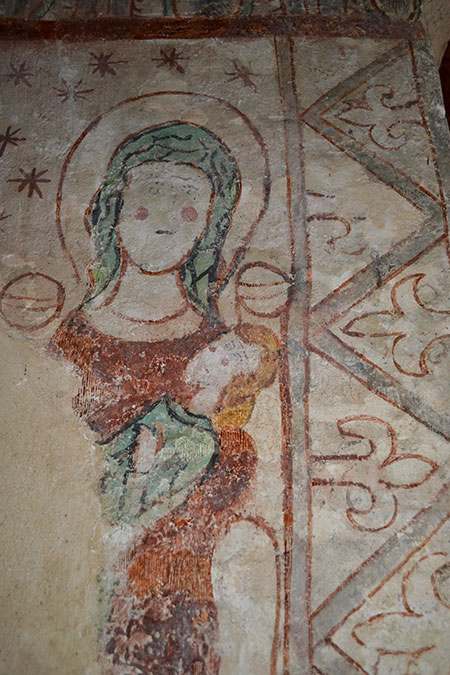Fresco's
Muurschilderingen in het schip van de kerk
Tijdens de restauratie van het schip (1941-1944) werd de witkalk van de muren gebikt. Veel te laat kwam men er achter dat er prachtige muurschilderingen onder het kalk verborgen zaten. Restaurateurs haalden de resterende kalklaag weg. Resultaat: de huidige, hier en daar incomplete en geschonden muurschilderingen.
 Rond de triomfboog en op de noordmuur zijn delen van 13e- en 14e- eeuwse muurschilderingen te zien. Naast de hagioscoop in de noordmuur is het geboorteverhaal van Christus uitgebeeld. Maria ligt op een boerenbed met een groene deken over. In haar armen houdt ze het ingebakerde Christuskind. De os en de ezel kijken toe. Daaronder is een drieluik, de aankondiging, (is verloren gegaan, een deel van een engelvleugel is te zien) vermoedelijk de aankondiging van de engel Gabriel aan Maria. Daarnaast waarschijnlijk Jozef of Jezus en rechts de ontmoeting van Maria met Elisabeth.
Rond de triomfboog en op de noordmuur zijn delen van 13e- en 14e- eeuwse muurschilderingen te zien. Naast de hagioscoop in de noordmuur is het geboorteverhaal van Christus uitgebeeld. Maria ligt op een boerenbed met een groene deken over. In haar armen houdt ze het ingebakerde Christuskind. De os en de ezel kijken toe. Daaronder is een drieluik, de aankondiging, (is verloren gegaan, een deel van een engelvleugel is te zien) vermoedelijk de aankondiging van de engel Gabriel aan Maria. Daarnaast waarschijnlijk Jozef of Jezus en rechts de ontmoeting van Maria met Elisabeth.
Boven de triomfboog is nog vaag een heiligengalerij te zien. Het is waarschijnlijk dat hier de apostelen te zien zijn. De grote figuur op de linker oostwand, de bovenkant van het lichaam is verdwenen, zou Christoffel kunnen zijn. Deze heilige werd in de 15e en 16e eeuw zeer groot afgebeeld. Het volksgeloof wil dat wie Christoffel heeft gezien, die dag niet zal sterven.
In de aansluitende nis is de vlucht naar Egypte geschilderd. Jozef loopt als een 'Drentse landloper' met zijn knapzak op z'n rug voor de ezel. Helaas is Maria in nevelen gehuld.

 Naast het noordelijk zijaltaar rechts naast de nis een muurschildering van Maria met het Christuskind op een troon. Dit is de enige afbeelding van een tronende Maria die na de reformatie nog is overgebleven in de kerk.
Naast het noordelijk zijaltaar rechts naast de nis een muurschildering van Maria met het Christuskind op een troon. Dit is de enige afbeelding van een tronende Maria die na de reformatie nog is overgebleven in de kerk.
Na de reformatie zijn de twee cartouches met teksten geschilderd. De tekst links van de boog is een oude, Nederduitse, tekst uit Spreuken 3. Mijn kindt vorgett mijn Gesette nith. Un dijn harte beware mijne gebode. wente se werde dij eyn lanck levent un go(-)ede jaren un Frede bringen.
Proverb 3ca.
(Vertaling:Mijn kind vergeet mijn wet niet
En je hart beware mijn geboden
Want ze zullen je een lang leven en
Goede jaren van vrede brengen. (Spreuken 3)

Achter deze tekst bevindt zich nog een fresco. Een vleugel van een engel is vaag zichtbaar.
De Latijnse tekst rechts betekent: "Niet geschreeuw maar liefde klinkt tot in het oor van God".




